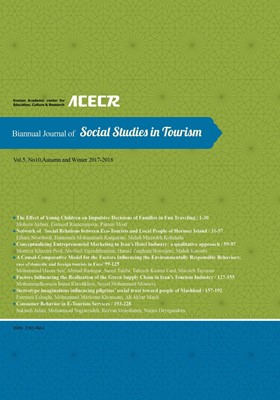A Causal-Comparative Model for the Factors Influencing the Environmentally Responsible Behaviors; case of domestic and foreign tourists in Fars
Subject Areas :Mohammad Hasan Seif 1 * , Ahmad Rastegar 2 , Saeed Talebi 3 , Marzieh Tajvaran 4
1 -
2 -
3 -
4 -
Keywords: Environment, ascription of responsibility, environmentalist behaviors,
Abstract :
In recent years, environmental issues have received greater attention within academic circles and society. They have also become a major social issue for larger numbers of people than ever before. Thus, the role of gender is emphasized in environmental orientation. The present study tried to examine the effective factors on the environmentalist behaviors of tourists in Fars. From the tourists who visited the province of Fars, 260 tourists were selected using the Cochran test. To enhance the credibility of findings, stratified random sampling was used and questionnaires were proportionally completed. All collected data were processed by SPSS software and were analyzed by descriptive and inferential statistics. Results showed that the highest total effects in tourists were the environmentalist behaviors and the lowest total effect was the ascription of responsibility.
ادهمی، عبدالرضا؛ اکبرزاده ، الهام. (1390). «بررسی عوامل فرهنگی مؤثر بر حفظ محیط زیست شهر تهران و مطالعه موردی مناطق 5 و 18 تهران». جامعه¬شناسی مطالعات جوانان. سال 1. شماره 1. صص 62-37.
اکبری، حسین. (1391). «نقش زنان در توسعه پایدار محیط زیست». زن در توسعه و سیاست. دوره 10. شماره 4. صص 56-37.
حسن زاده، فریبا. (1394). «گردشگری سبز، محیط زیست و توسعه پایدار». فضای گردشگری. سال 4. شماره14. صص 47-39.
حقیقتیان، منصور؛ پورافکاری، نصرالله؛ جعفری نیا، غلامرضا. (1391). «تأثیر رفتارهای اجتماعی زیست¬محیطی بر توسعه اجتماعی مورد مطالعه کارکنان پارس جنوبی( عسلویه)». مطالعات توسعه اجتماعی ایران. سال 5. شماره1. صص 152-135.
حقیقی، محمد؛ خلیل، مریم. (1390). «بررسی جایگاه بازاریابی سبز در رفتارخرید مصرف کنندگان». مدیریت فرهنگ سازمانی. دوره 9. شماره2. صص 102-83.
علیقلی¬زاده فیروزجایی، ناصر؛ رمضان زاد سبویی، مهدی؛ اسمعیلی، مجید. (1394). «سنجش رفتارهای زیست¬محیطی گردشگران در مقصدهای کویری و بیابانی، مطالعه موردی نواحی روستایی شهرستان خور و بیابانک». پژوهش¬های روستایی. دوره 6. شماره 2. صص 274-253.
فیروزجائیان، علی اصغر؛ غلامرضازاده، فاطمه.(1394). «شرایط محیطی اثر گذار بر زباله پراکنی در استان مازندران با تأکید بر شرایط محیطی تسهیل کننده آن». مطالعات مدیریت گردشگری. سال 10. شماره 29. صص 144-123.
نخعی، آرزو؛ خیری، بهرام.(1391). «بررسی تاثیر عوامل منتخب بر قصد خرید محصولات سبز». مدیریت بازاریابی. شماره15. دوره7. صص 130-105
Birdir, S., Unal,€ O., Birdir, K., & Williams, A. T. (2013). Willingness to pay as an economic instrument for coastal tourism management: Cases from Mersin, Turkey. Tourism Management, 36,279-283
Brehm, J. M.; Eeisenhauer, B. W. & Krannich, R. S. 2006. Community attachments as predictors of local environmental concern: The case for multiple dimensions of attachment. American Behavioral Scientist, 50(2): 142-165.
Buckley, R. (2011). Tourism and Environment. In A. Gadgil, & D.M. Liverman (Eds.), Annual Review of Environment and Resources, 397–416. Burgin, S. & Hardiman, N. (2011). The direct physical, chemical and biotic impacts on Australian coastal waters due to recreational boating, Biodiversity and Conservation, 20(4): 683-701.
Cheng, J. C. H., & Monroe, M. C. (2012). Connection to Nature : Children's Affective Attitude Toward Nature, Environment andBehavior, 44(1): 31-49 Chiu, Y.-T. H., Lee, W.-I., & Chen, T.-H. (2014). Environmentally responsible behavior in ecotourism: Antecedents and implications,Tourism Management, 40, 321-329
Griscom, H.P. & Ashton, M.S. (2011). Restoration of dry tropical forests in Central America: a review of pattern and process, Forest Ecology and Management, 261(10): 1564-1579.
Halpenny, E. A. (2010). Pro-environmental behaviours and park visitors: The effect of place attachment, Journal of Environmental Psychology, 30(4), 409-421.
Imran, S. Alam. KH, Beaumont.N,.(2014). Environmental orientations and environmental behaviour: Perceptions of protected area tourism stakeholders,Tourism Management,40, 290–299.
Jang, Y., Kim, W., Bonn, M.( 2011).Generation Y consumer s selection attributes and behavioural intentions concerning green restuarants, Int. J. Hosp. Manag,30 (4),803-811.
Kafyri, A., Hovardas, T., Poirazidis, K.(2012). Determinants of Visitor Pro-Environmental Intentions on Two Small Greek Islands: Is Ecotourism Possible at Coastal Protected Areas? Environmental Management, 50, 1, 64–76
Lee, T. H., Jan, F.-H., & Yang, C.-C. (2013). Conceptualizing and measuring environmentally responsible behaviors from the perspective of community-based tourists,Tourism Management, 36, 454-468.
Lee, W.S., Graefe, A.R. & Hwang, D.( 2013).Willingness to Pay for an Ecological Park Experience, Asia Pacific,Journal of Tourism Research, 18(3), 288–302.
Papadopoulos, I., Karagouni, G., Trigkas, M. Platogianni, E. (2010). Green marketing: The case of Greece in certified and sustainably managed timber products, EuroMed Journal of Business, 5, 2, 166-190
Quintal,V.A., Julie Anne Lee,J.A,. Soutar,G.N.(2010). Risk, uncertainty and the theory of planned behavior: A tourism example, Tourism management. 31(6):797-805.
Stubelj Ars.M.(2014). Decision Support in the Implention of Sustainable Development in Protected Areas Regarding Environmental Education and Ecotourism,University of Nova Gorica Graduate School.
Walker, G. J., & Chapman, R.( 2003). Thinking like a park: The effects of sense of place, perspective-taking, and empathy on pro-environment intentions, Journal of Park and Recreation Administration, 21(4): 71-86.
Wang, P.-W., & Jia, J.-B. (2012). Tourists' willingness to pay for biodiversity con- servation and environment protection, Dalai Lake protected area: Implications for entrance fee and sustainable management, Ocean & Coastal Management, 62, 24-33.

